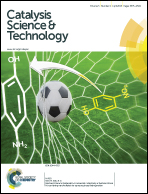Catalytic asymmetric [3,3]-rearrangements of allylic acetimidates†
Abstract
A streamlined synthetic access to enantiomerically pure allylic amines as advanced and valuable synthetic building blocks is important for pharmaceutical sciences. The rearrangement of allylic trihaloacetimidates is known as an attractive method to furnish branched chiral allylic trihaloacetamides with high levels of enantio- and regioselectivity. In the present article we report our studies on the catalytic asymmetric rearrangement of the corresponding non-halogenated acetimidates, which might provide economic advantages by avoiding CX3 groups. The regioselective title reaction proceeds with high levels of enantioselectivity, provides high yields and requires only low catalyst loadings. In addition, the generated N-acetyl and N-phenacetyl functionalities offer the option of a subsequent mild enzymatic amide hydrolysis to get access to nearly enantiopure allylic amines.
![Graphical abstract: Catalytic asymmetric [3,3]-rearrangements of allylic acetimidates](/en/Image/Get?imageInfo.ImageType=GA&imageInfo.ImageIdentifier.ManuscriptID=C4CY01749H&imageInfo.ImageIdentifier.Year=2015)

 Please wait while we load your content...
Please wait while we load your content...